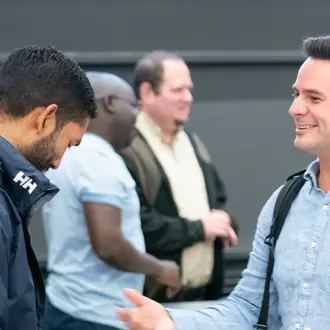MIT Sloan Fellows Roundtable: Alumni from around the globe weigh in on the new realities facing entrepreneurs in the post-pandemic world
Meet the pundits
- Chandra Briggman, SF ’14—United States
- President and CEO of Activation Capital, an independent authority of Virginia that supports the growth of advanced technology entrepreneurship by providing physical space, programming, and funding to the entrepreneurial ecosystem.
- Lais Fonseca, SFMBA ’19—Brazil
- Serial entrepreneur and founder/CEO of Brazilian healthcare startup Precavida; leadership coach at Success Lab; member of the Techstars 2020 accelerator; MIT Legatum Fellow.
- Claude Grunitzky, SF ’12—Togo/France/United States
- Founder of the Equity Alliance, which seeks to democratize entrepreneurial opportunities for women and people of color; founder of True Africa, an online platform championing young African voices through media and education.
- Ray Leach, SF ’02—United States
- Founding CEO of JumpStart, a Cleveland, Ohio-based venture development nonprofit; founding member of the National Advisory Council on Innovation and Entrepreneurship; serves on the board of Venture Forward, a nonprofit dedicated to advancing a more diverse and inclusive entrepreneurial ecosystem.
What kinds of businesses will flourish in the next few years?
Chandra Briggman: We've seen a huge spike in the life sciences as researchers try to create vaccines and life-saving drugs in response to the pandemic. Growth in that sector and healthcare will outlast the pandemic as innovators seek solutions for an aging population and apply emerging technology to healthcare and biotech. We're also communicating, collaborating, and educating differently now—less phone, more Zoom. It's unlikely that post-pandemic we simply will reverse course and go back to how things used to be, so enterprises that embrace new communications models are heating up as well.
Ray Leach: One company in the JumpStart portfolio creates virtual college enrollment tools to assist new students. Since the start of the pandemic, the company went from 2 to 50 universities using this service in only nine months. Another success story is a company that offers a streaming platform that gives organizations the capability to deliver live, high-quality video to anyone, anywhere. It requires a minimum of technical knowledge, so churches, schools, yoga studios, and organizations not experienced in the virtual environment could quickly get up and running. Most notably, the pandemic has been to virology what the iPhone was to communications—it’s blowing open the field and accelerating the pace of innovation.
Lais Fonseca: The healthcare space in general is very hot right now. I see digital therapies, in particular, as an area ripe for entrepreneurship. It’s a marriage of the advances in healthcare and virtual communications that are emerging now. Digital therapies will make it possible for healthcare providers to connect with patients virtually and treat, manage, and prevent a wide range of health issues. Digital therapies also will give patients a more active role in their healthcare because the interventions take place on their home turf rather than in the doctor’s office.
Claude Grunitzky: Three categories of companies look promising to me. The first focuses on the new consumer—those who live on the phone. Consumers are developing new habits in the way they carry out the key tasks in their lives, and more and more shopping habits are tied to the smartphone. The second—the new lifestyle. The pandemic has altered forever our conventions about the workplace and how we balance our home life and work. And third, the new enterprise—tapping into the latest capabilities in machine learning and AI, tools that will enable us to be more productive in the workplace in order to actually work less and do all of the above. Enterprises that look into the future and envision where we’re going in these three categories will have the greatest opportunities to thrive.
Ray Leach: We also have seen an explosion in social entrepreneurship. COVID has exposed inequities and long-standing challenges in our society that hold us back individually and collectively. People want to solve those problems but not as capitalists. They don’t want to get rich on their solutions, they just want to make a difference as expediently as possible. The bottom line for them is the benefit to society, not the profit margin. Eighty percent of these social entrepreneurs are focusing on urban issues that have come to light during the pandemic.
Do you recommend that entrepreneurs resist the lure of venture capital or should they jump at any opportunity for funding in a competitive marketplace?
Ray Leach: The venture capital universe is morphing as we speak. Funding activity has not slowed down at all during the pandemic, but the process has changed dramatically. Venture capital investment used to be primarily in three states, but the pandemic has accelerated the transformation of this dynamic. Right now, most entrepreneurs can only meet with VCs virtually, so it doesn’t matter if the entrepreneur is in Silicon Valley or the Tennessee Valley. The pandemic has dramatically democratized the playing field to a great extent. It used to be unheard of for a VC to invest without meeting the founders, but now it’s the way things are done. It doesn’t matter where you’re Zooming from. Four walls in Tuscaloosa look pretty much the same as four walls in Cambridge. As a result, 30 percent of recent investments by VCs have been in enterprises based in other parts of the country. Entrepreneurs in smaller markets are suddenly gaining the attention they deserve. Geographic barriers are disappearing in the world of venture capital in a way no one would have anticipated a few years ago.
Chandra Briggman: It's good to remember that less than one percent of entrepreneurs get venture capital, so don't start a new enterprise with the goal of venture funding. Savvy entrepreneurs develop a sustainable revenue model that does not depend on VC money. For one thing, VCs are typically interested in investing in massively disruptive IP and ventures and expect outsized returns on those investments. Most ideas simply don't meet that criteria. The vast majority of startups should consider a variety of funding options in their path forward, including funding growth from revenue. Another thing to consider is that once you are taking venture capital, you will give up some degree of ownership. At that point, it's not all about your individual vision. So, if your motivation to start a tech business is autonomy, please know that you work for your investors once you accept venture capital.
Claude Grunitzky: If you’re just starting out, VC money shouldn’t be your first choice. Look for grants, enter entrepreneurshipcompetitions, appeal to individual angel investors who don’t put such strict terms in front of you. The pressure to satisfy VCs and predatory angels is huge. Often their principal value is the funding. They can otherwise be a drag on the organization, discouraging bold ideas and novel approaches. One path is to find a simpatico cofounder who brings different skills and a different network to the enterprise, doubling your resources and support systems. Stay lean.Lais Fonseca: In my case, I engaged with angel investors—people who were investing their own money because they believed in what I was doing. Doctors, for example. Okay, it was $5,000 here and $10,000 there, but I reached where I needed to go and launched my healthcare startup, which now employs 12 people. I also entered competitions and joined networks in rich entrepreneurial ecosystems like MIT and Harvard. Because my company will increase access to healthcare—and reduce costs to companies along the way— I was able to appeal to angel investors within the medical community who were excited at the prospect of transforming healthcare.
Chandra Briggman: I'd like to add that some startup categories are capital intensive to break into. They require large cash infusions to build, scale, and achieve success. Startups in the biotech, robotics, and energy spaces are among them. It takes a lot of money to bring life sciences innovations to market. You don't invent vaccines in your garage with a little seed money.
Do you think social justice movements like #MeToo and Black Lives Matter have improved diversity within the entrepreneurship realm?
Lais Fonseca It’s too soon to say. As it stands, only three percent of women get venture capital for their startups. Especially in emerging markets, a woman is unlikely to be able to raise VC funds for her enterprise. I have always felt that, as a woman CEO, I have had to work twice as hard and perform twice as brilliantly as the average man. Some of my male peers raise money with a simple PowerPoint, while I have had to jump through many more hoops to overcome the doubts of funders, even though I have a track record of success. As a woman, you never know if a VC is evaluating you or your business idea.
Ray Leach: I think that both the #MeToo and BLM movements have heightened awareness about the institutional prejudices that have existed in the entrepreneurial world. Organizations like mine have been focused for years on these dynamics, but others are now joining in to make more significant change. Many white male entrepreneurs have networks of white males, because most entrepreneurs tend to be white males. At JumpStart, we are diversifying the pipeline of talent so if a startup needs a CFO or a marketing director, we can point them to a more diverse pool of Black and Latinx candidates. We have found a lot of enthusiasm among founders of all genders and races for diversifying their teams. If we can help them do that, we all win.
Chandra Briggman: The movements have certainly raised awareness and allowed the tech community to think about the value of diverse entrepreneurs. Here's the thing - entrepreneurs are entrepreneurs because they want to solve big problems. We need input and perspectives from all areas of society to solve the wide array of problems in every area of life. For example, there are challenges unique to the female existence that might not see solutions developed if female entrepreneurs are not supported. Organizations like mine around the country are providing resources and mentorship to those entrepreneurs who might not have crucial support systems in place. We recently launched a capacity-building initiative to grow minority tech entrepreneurship because we see that as a huge opportunity area in our region.
Claude Grunitzky: If things are changing, it’s because many people are dedicated to making that change. The work we’re doing with Equity Alliance, for example. We’re providing funding to women and people of color, both venture capital fund managers and entrepreneurs who historically have been shut out of capital markets. Funding and mentoring entrepreneurs in the under-resourced community is an opportunity to change the way the world works. The #MeToo and BLM movements are helping to accelerate that change. Institutions, corporations, philanthropic sources—they’ve begun to make commitments to equity because they want to be on the right side of history.
Ray Leach: It’s also important to diversify the venture industry and ecosystem. Right now, five percent of venture capitalists are Black or Latinx, thirty percent are Southeast Asian, and the rest are white. In our work on the board of Venture Forward, we’re focused on diversifying the VC industry and the portfolio of companies they invest in. We’ve been working at these goals for a while, but we’re definitely seeing a much higher consciousness level around issues of sexism and racism in the entrepreneurial world.
Lais Fonseca: One recommendation I have for women and people of color—develop an affiliation with an academic community if you can. I have been able to rely on the entrepreneurial resources of academic ecosystems like MIT, where the landscape is more equitable for entrepreneurs who aren’t white men. You’ll build a very deep network, too, that will serve you well as you develop ventures.
Each of you has earned your entrepreneurial battle scars. What tips can you share for navigating the new realities of entrepreneurship?
Lais Fonseca: I have a passion for the healthcare space, for making high-quality healthcare accessible to everyone, but I know I must never lose sight of customer behavior and tendencies. An entrepreneur has to be careful not to get swept up in a great idea for its own beautiful sake. Focus on the customers. Will they gravitate toward your idea? Does it truly, elegantly solve an important problem? Always be prepared to pivot toward customer behavior as it changes direction. Your idea is not so great if it’s not sustainable, if consumers are not inclined to adopt it, or if you can’t change gears when you need to.
Claude Grunitzky: The Zoom app we all downloaded at the start of the pandemic is not the Zoom we are experiencing now. That’s because the company was fleet-of-foot in responding to glitches and shortcomings, including the notorious “zoombombing” episodes many of us experienced in the spring of 2020. It’s a case study in the kind of versatility necessary to scale up successfully. Other virtual platforms are succeeding, too, but Zoom, arguably, has held on to the lead. The pandemic has altered some industries forever—not just temporarily—and the smart entrepreneur will create an enterprise that will outlast our isolation. The new workout innovation Mirror, for example, allows you to exercise in front of your mirror with live virtual trainers. As gyms like Equinox are struggling, entrepreneurs who are redefining how and when we work out will have a good chance of success.
Ray Leach: Yes, entrepreneurs who have businesses that are thriving in the pandemic environment must look ahead to how they will pivot when people can travel freely again. Make sure your enterprise isn’t pandemic-dependent. Build your relationships with customers so that when the world has opened up again, they respect and value you and want to stick with you as you change lanes—maybe from offering virtual tours of campus, for example, to broader video services. How do you turn an advantageous blip into a sustainable future? Also, think about solving a piece of a problem, not the whole high-level problem. Institutional racism is a good example. Try to solve manageable pieces of that challenge—maybe tackle pay equity or healthcare issues. Break it down to individual, winnable goals.
Chandra Briggman: Decide what kind of an entrepreneur you want to be—a kitchen table entrepreneur or a high-growth CEO running a company like Uber, Bumble, or Calendly—or somewhere in between. Each comes with challenges and rewards, so think that through first. The second piece of advice is that as an entrepreneur, your job is to solve a real problem for enough people that you can make a living. Don’t jump into entrepreneurship believing that your job is to build the assortment of ideas in your head without ever validating that anyone needs your solution or is willing to pay for it. In that case, you will experience a lot of emotional and financial heartache. And understand the need to be agile, because the business concept you begin with is rarely the one you launch. Be prepared to talk to many customers and to let go of what you think the market needs in order to respond to actual customer needs.
Claude Grunitzky: Don’t become intoxicated by your own vision of yourself as some sort of charismatic founder. The aura of being a young founder can be intoxicating, but don’t get caught up in your own hype. Make sure you’re creating something meaningful and make sure the value of it is confirmed in the marketplace before you go test-driving that Porsche.



